Historically, worm gears have been known as the most common type of gears used in a right angle gearhead. Their low cost and robust construction have been sufficient for general purpose applications. However, they are inefficient at slower speeds (higher reduction ratios), produce a lot of heat, take up a lot of space, and require maintenance. As efficiency standards became increasingly important globally, another type of gear is being adopted for right angle gearheads.
Typically used in automotive applications, hypoid gears have been integrated into right angle gear motors to eliminate the problems caused by worm gears as well as to increase performance of right angle gear motors. The initial cost of hypoid gear motors may be higher than worm gear motors due to machining, heat treatment, and special grinding techniques, but long term benefits can outweigh the initial cost for many applications.
Differences
In a worm gear set, there are two components: the input worm and the output worm gear. The input worm is a screw-like gear that rotates perpendicular to its corresponding output worm gear. In a worm gearhead with a 5:1 ratio, the input worm will complete 5 revolutions while the output worm gear will complete only one. However, torque is not multiplied by a factor of 5 since a lot of torque is lost through sliding friction.
In comparison, the hypoid gear set consists of a input hypoid gear and an output hypoid bevel gear. Although the hypoid gear set is a hybrid of bevel and worm gear technologies, the gear efficiency is much higher even in high reduction ratios. The key is that the hypoid tooth pattern minimizes sliding friction between the gear teeth to allow more torque transfer from motor shaft to load shaft.
|
To learn more about the differences between hypoid and worm gears, please read our white paper, "Hypoid vs. Worm Gears: A More Cost Effective Right-Angle Reducer". |
In this post, we will summarize the performance differences between hypoid and worm gears from the white paper.
- Better gear efficiency
- Less heat generation
- Smaller footprint
- Lower Power Consumption
Better Gear Efficiency
One of the biggest issues with worm gears is its low efficiency for torque transfer. Typically, worm gear efficiency can vary from 40% to 85% for ratios of 60:1 to 10:1 respectively. They also require a "break-in" period in order to run at peak efficiency. Hypoid gear efficiency is up at 95% to 99% and do not require a break-in period.
Due to increasing importance in reducing power consumption (see IE3 or NEMA Premium Efficiency), efficiency is now one of the most important factors to consider when choosing a gear motor. Since motors already have a long life, choosing an efficient gearhead to go with the motor makes a lot of sense in reducing maintenance costs.
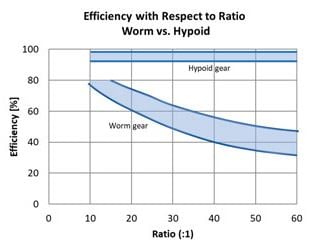
Less Heat Generation
A higher efficiency gearhead will waste less energy. Friction is wasted energy that takes the form of heat. Since worm gears produce more sliding friction than hypoid gears, they run hotter, which reduces the service life of these drivers by putting extra thermal stress on the lubrication, bearings, seals and gears.
Since hypoid gears run cooler due to minimized sliding friction, there is little to do to keep them running at peak performance. There is no need to replace lubricants because the grease is meant to last the lifetime of the gear motor. This can help eliminate downtime and increase productivity. In addition, cooling fins, breather holes and other peripherals used for cooling is eliminated, contributing to lower operating costs.
When we run a hypoid gearbox and a worm gearbox with the same motor side by side, we found that when the temperatures leveled off, there is a significant difference of 26.4°F.
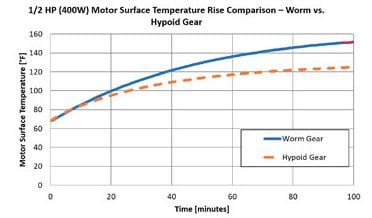
Smaller Footprint
Due to the way the axes of the gears intersect, the hypoid gear set requires a smaller footprint than womr gear sets. This helps in applications where space is a constraint.
| Hypoid | Worm |
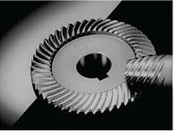 |
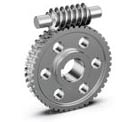 |
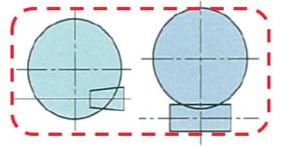
Another benefit of hypoid gear motors is that they are symmetrical axially from the motor shaft to the load shaft. Worm gear motors are asymmetrical and result in machines that are not as aesthetically pleasing, and mounting options are limited.
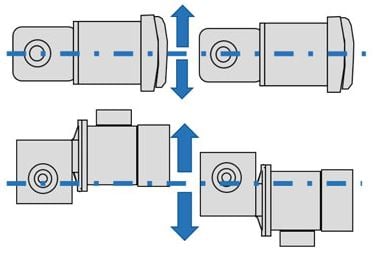
Less Power Consumption
In some cases, a smaller motor can be used to provide equivalent torque for the same application. Here we compare a hypoid gear motor with a worm gear motor of similar output. Notice that the hypoid gear motor uses a 1/2 HP motor while the worm gear motor uses a 1 HP motor. Along with less wasted energy from the sliding friction of the gears, the smaller motor contributes to even lower power consumption costs.
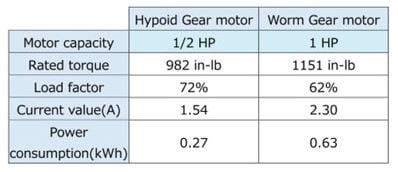
Conclusion
The higher efficiency and design from hypoid gears presents many advantages over worm gears from higher torque transfer, lower operating temperatures, smaller footprint, higher reliability, longer life, and less power consumption. This ultimately leads to lowering operating costs in the long run, and the ability to design smaller machines. Although upfront costs can be higher for hypoid gears, the advantagses should offer something to think about when selecting motors for your next machine.
|
To learn more about the differences between hypoid and worm gears, please read our white paper, "Hypoid vs. Worm Gears: A More Cost Effective Right-Angle Reducer". |
Oriental Motor offers right angle hypoid gearhead options on the Brother Mid H2 Series, Brother Mid F3 Series, BMU Series, BLE2 Series, and K2S Series (coming soon).
 |
 |
 |
 |
| TIP: once you select a motor size by HP or watts, use the filter options on the left side and filter Shaft/Gear Type for "Right-Angle". |
Example:

Interested in receiving new posts? Please subscribe at the top of this page.




